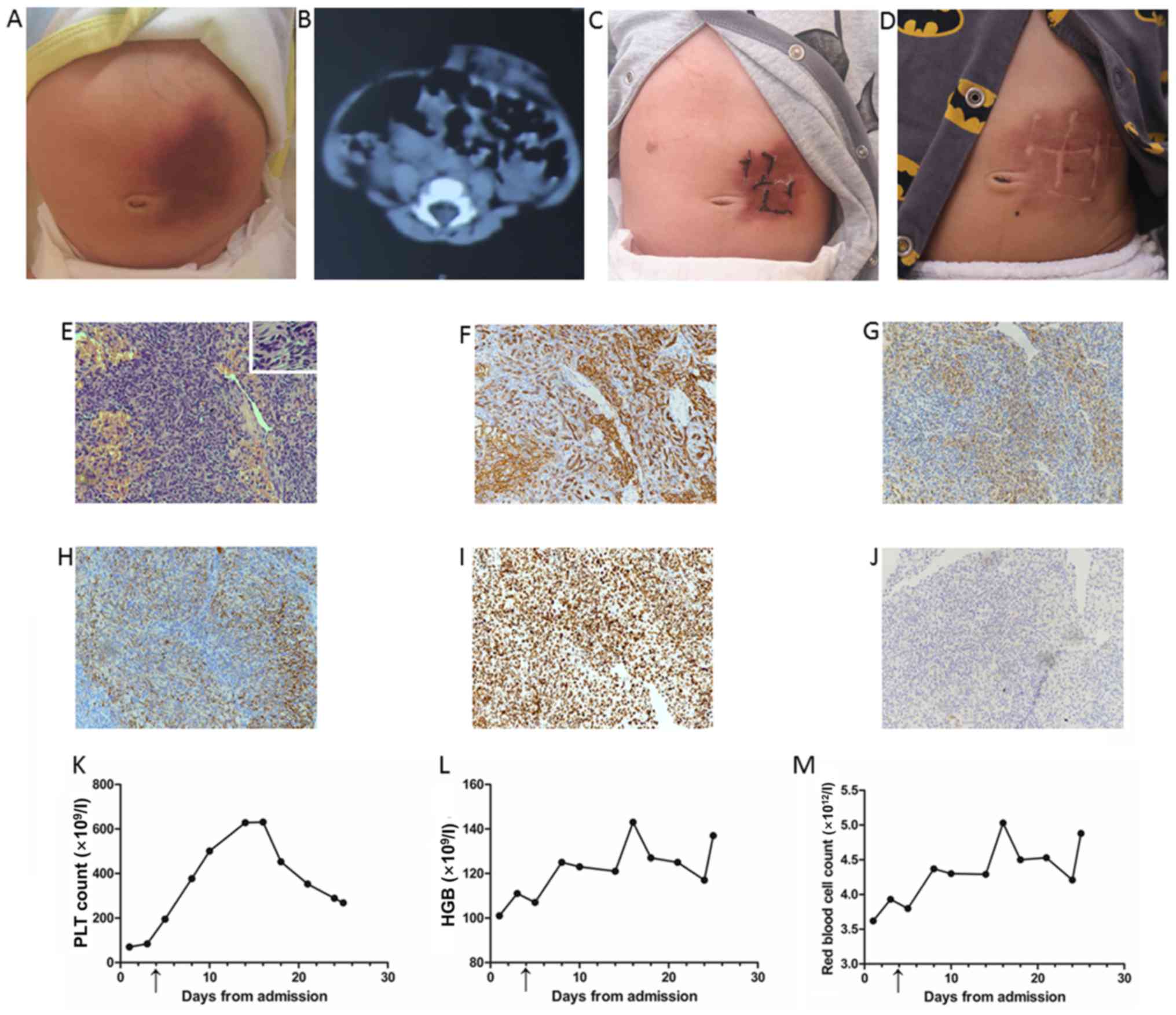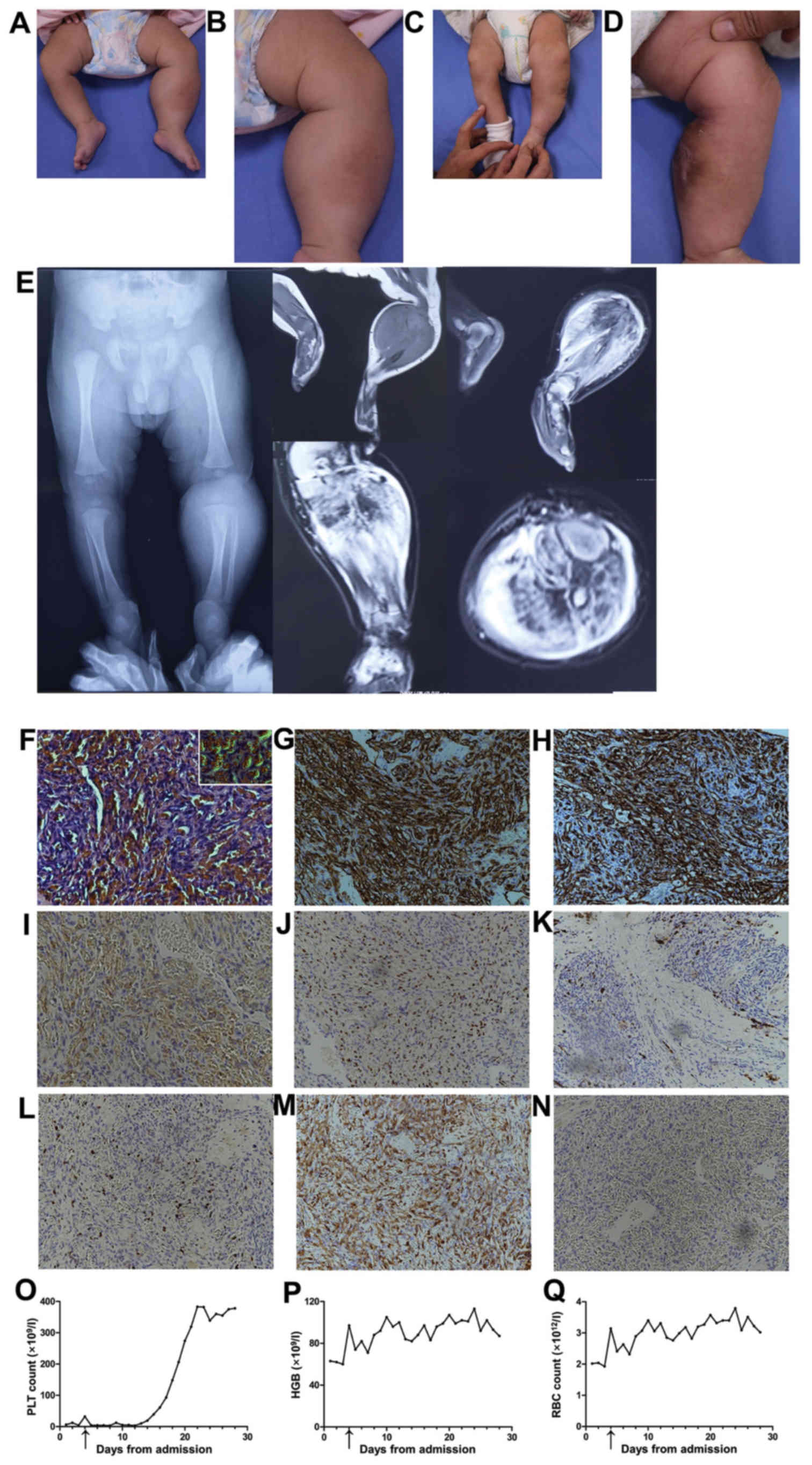|
1
|
Zukerberg LR, Nickoloff BJ and Weiss SW:
Kaposiform hemangioendothelioma of infancy and childhood. An
aggressive neoplasm associated with Kasabach-Merritt syndrome and
lymphangiomatosis. Am J Surg Pathol. 17:321–328. 1993. View Article : Google Scholar : PubMed/NCBI
|
|
2
|
Croteau SE, Liang MG, Kozakewich HP,
Alomari AI, Fishman SJ, Mulliken JB and Trenor CC: Kaposiform
hemangioendothelioma: Atypical features and risks of
Kasabach-Merritt phenomenon in 107 referrals. J Pediatr.
162:142–147. 2013. View Article : Google Scholar : PubMed/NCBI
|
|
3
|
Kasabach HH and Merritt KK: Capillary
hemangioma with extensive purpura. Am J Dis Child. 59:1063–1070.
1940. View Article : Google Scholar
|
|
4
|
Garcia-Monaco R, Giachetti A, Peralta O,
Napoli N, Lobos P, Gioseffi L and Mariani G: Kaposiform
hemangioendothelioma with Kasabach-Merritt phenomenon: Successful
treatment with embolization and vincristine in two newborns. J Vasc
Interv Radiol. 23:417–422. 2012. View Article : Google Scholar : PubMed/NCBI
|
|
5
|
Mahajan P, Margolin J and Iacobas I:
Kasabach-Merritt phenomenon: Classic presentation and management
options. Clin Med Insights Blood Disord. 10:1179545X176998492017.
View Article : Google Scholar : PubMed/NCBI
|
|
6
|
Chiu YE, Drolet BA, Blei F, Carcao M,
Fangusaro J, Kelly ME, Krol A, Lofgren S, Mancini AJ, Metry DW, et
al: Variable response to propranolol treatment of Kaposiform
hemangioendothelioma, tufted angioma, and Kasabach-Merritt
phenomenon. Pediatr Blood Cancer. 59:934–938. 2012. View Article : Google Scholar : PubMed/NCBI
|
|
7
|
Jiang RS and Hu R: Successful treatment of
Kasabach-Merritt syndrome arising from Kaposiform
hemangioendothelioma by systemic corticosteroid therapy and
surgery. Int J Clin Oncol. 17:512–516. 2012. View Article : Google Scholar : PubMed/NCBI
|
|
8
|
Beaubien ER, Ball NJ and Storwick GS:
Kaposiform hemangioendothelioma: A locally aggressive vascular
tumor. J Am Acad Dermatol. 38:799–802. 1998. View Article : Google Scholar : PubMed/NCBI
|
|
9
|
Liu X, Li J, Qu X, Yan W, Zhang L, Zhang
S, Yang C and Zheng J: Clinical outcomes for systemic
corticosteroids versus vincristine in treating Kaposiform
hemangioendothelioma and tufted angioma. Medicine. 95:e34312016.
View Article : Google Scholar : PubMed/NCBI
|
|
10
|
Lyons LL, North PE, Mac-Moune Lai F,
Stoler MH, Folpe AL and Weiss SW: Kaposiform hemangioendothelioma:
A study of 33 cases emphasizing its pathologic, immunophenotypic,
and biologic uniqueness from juvenile hemangioma. Am J Surg Pathol.
28:559–568. 2004. View Article : Google Scholar : PubMed/NCBI
|
|
11
|
Vivas-Colmenares GV, Ramirez-Villar GL,
Bernabeu-Wittel J, Matute de Cardenas JA and Fernandez-Pineda I:
The importance of early diagnosis and treatment of Kaposiform
hemangioendothelioma complicated by Kasabach-Merritt phenomenon.
Dermatol Pract Concept. 5:91–93. 2015. View Article : Google Scholar : PubMed/NCBI
|
|
12
|
van de Velde ME, Kaspers GL, Abbink FCH,
Wilhelm AJ, Ket JCF and van den Berg MH: Vincristine-induced
peripheral neuropathy in children with cancer: A systematic review.
Crit Rev Oncol Hematol. 114:114–130. 2017. View Article : Google Scholar : PubMed/NCBI
|
|
13
|
Mota JM, Scaranti M, Fonseca LG, Tolói DA,
de Camargo VP, Munhoz RR, Feher O and Hoff PM: Response to
paclitaxel in an adult patient with advanced Kaposiform
hemangioendothelioma. Case Rep Oncol. 9:481–487. 2016. View Article : Google Scholar : PubMed/NCBI
|
|
14
|
Alaqeel AM, Alfurayh NA, Alhedyani AA and
Alajlan SM: Sirolimus for treatment of Kaposiform
hemangioendothelioma associated with Kasabach-Merritt phenomenon.
JAAD Case Rep. 2:457–461. 2016. View Article : Google Scholar : PubMed/NCBI
|
|
15
|
Ji Y, Chen S, Xiang B, Li K, Xu Z, Yao W,
Lu G, Liu X, Xia C, Wang Q, et al: Sirolimus for the treatment of
progressive Kaposiform hemangioendothelioma: A multicenter
retrospective study. Int J Cancer. 141:848–855. 2017. View Article : Google Scholar : PubMed/NCBI
|
|
16
|
Daemen J, Wenaweser P, Tsuchida K, Abrecht
L, Vaina S, Morger C, Kukreja N, Jüni P, Sianos G, Hellige G, et
al: Early and late coronary stent thrombosis of sirolimus-eluting
and paclitaxel-eluting stents in routine clinical practice: Data
from a large two-institutional cohort study. Lancet. 369:667–678.
2007. View Article : Google Scholar : PubMed/NCBI
|
|
17
|
Reichel A, Hamm H, Wiegering V, Wiewrodt
B, Neubauer H, Ernestus K and Winkler B: Kaposiform
hemangioendothelioma with Kasabach-Merritt syndrome: Successful
treatment with sirolimus. J Dtsch Dermatol Ges. 15:329–331. 2017.
View Article : Google Scholar
|
|
18
|
Triana PJ, Dore M, Nuñez VC, Jimenez JG,
Miguel MF, Díaz MG, Ricardo JN, Andres A, Santamaria ML and
Lopez-Gutierrez JC: Pancreatic Kaposiform hemangioendothelioma not
responding to sirolimus. Eur J Pediatr Surg Rep. 5:e32–e35. 2017.
View Article : Google Scholar
|
|
19
|
Azma R, Alavi S, Khoddami M, Arzanian MT,
Nourmohammad A and Esteghamati S: Multifocal kaposiform
hemangioendothelioma of soft tissue with bilateral pulmonary
involvement in an adolescent. Korean J Pediatr. 57:500–504. 2014.
View Article : Google Scholar : PubMed/NCBI
|
|
20
|
Guo X, Gong Y and Dong C: Surgical
treatment of a huge kaposiform hemangioendothelioma in the chest
wall: A case study. SAGE Open Med Case Rep.
4:10.1177/2050313X16684742. 2016.PubMed/NCBI
|
|
21
|
Zahir ST, Benrazavi SS and Binesh F:
Kaposiform hemangioendothelioma: Report of a case unresponsive to
usual medical treatments. J Res Med Sci. 14:389–392.
2009.PubMed/NCBI
|
|
22
|
Leung M, Chao NS, Tang PM, Liu K and Chung
KL: Pancreatic kaposiform hemangioendothelioma presenting with
duodenal obstruction and kasabach-merritt phenomenon: A neonate
cured by Whipple operation. Eur J Pediatr Surg Rep. 2:7–9. 2014.
View Article : Google Scholar
|
|
23
|
Vashi P, Abboud E, Bier-Laning C and Gupta
D: Adult-onset kaposiform hemangioendothelioma of the tongue: Case
report and review of the literature. Curr Oncol. 23:e517–e520.
2016. View Article : Google Scholar : PubMed/NCBI
|
|
24
|
Vetter-Kauczok CS, Ströbel P, Bröcker EB
and Becker JC: Kaposiform hemangioendothelioma with distant
lymphangiomatosis without an association to
Kasabach-Merritt-Syndrome in a female adult! Vasc Health Risk
Manag. 4:263–266. 2008. View Article : Google Scholar : PubMed/NCBI
|
|
25
|
Kurian JJ, Kishore R, John TJ and Parmer
H: A rare case of kaposiform hemangioendothelioma presenting as
intussusception in a 4-month-old child without Kasabach-Merrit
syndrome: A case report. J Indian Assoc Pediatr Surg. 19:233–235.
2014. View Article : Google Scholar : PubMed/NCBI
|
|
26
|
Dong A, Zhang L, Wang Y, He T and Zuo C:
Abdominal kaposiform hemangioendothelioma associated with
lymphangiomatosis involving mesentery and ileum: A case report of
MRI, CT, and 18F-FDG PET/CT findings. Medicine (Baltimore).
95:e28062016. View Article : Google Scholar : PubMed/NCBI
|
|
27
|
Cinotti E and Rongioletti F: Kaposiform
hemangioendothelioma. In: Rare malignant skin tumors. Rongioletti
F, Margaritescu I and Smoller BR: Springer; New York, NY: pp.
161–164. 2015
|
|
28
|
Sarkar M, Mulliken JB, Kozakewich HP,
Robertson RL and Burrows PE: Thrombocytopenic coagulopathy
(Kasabach-Merritt phenomenon) is associated with Kaposiform
hemangioendothelioma and not with common infantile hemangioma.
Plast Reconstr Surg. 100:1377–1386. 1997. View Article : Google Scholar : PubMed/NCBI
|
|
29
|
Esterly NB: Kasabach-Merritt syndrome in
infants. J Am Acad Dermatol. 8:504–513. 1983. View Article : Google Scholar : PubMed/NCBI
|
|
30
|
O'Rafferty C, O'Regan GM, Irvine AD and
Smith OP: Recent advances in the pathobiology and management of
Kasabach-Merritt phenomenon. Br J Haematol. 171:38–51. 2015.
View Article : Google Scholar : PubMed/NCBI
|
|
31
|
Putra J and Gupta A: Kaposiform
haemangioendothelioma: A review with emphasis on histological
differential diagnosis. Pathology. 49:356–362. 2017. View Article : Google Scholar : PubMed/NCBI
|
|
32
|
Le HA, Jokinen CH, Rubin BP, Mihm MC,
Weiss SW, North PE and Dadras SS: Expression of prox1, lymphatic
endothelial nuclear transcription factor, in Kaposiform
hemangioendothelioma and tufted angioma. Am J Surg Pathol.
34:1563–1573. 2010.PubMed/NCBI
|
|
33
|
Szlachetka DM: Kasabach-Merritt syndrome:
A case review. Neonat Netw. 17:7–15. 1998.
|
|
34
|
Ryan C, Price V, John P, Mahant S,
Baruchel S, Brandão L, Blanchette V, Pope E and Weinstein M:
Kasabach-Merritt phenomenon: A single centre experience. Eur J
Haematol. 84:97–104. 2010. View Article : Google Scholar : PubMed/NCBI
|
|
35
|
Traivaree C, Lumkul R, Torcharus K,
Krutuecho T and Sriphaisal T: Outcome of Kasabach-Merritt
phenomenon: The role of vincristine as monotherapy: Report of a
case. J Med Assoc Thai. 95 Suppl 5:S181–S185. 2012.PubMed/NCBI
|
|
36
|
Dubois J, Hershon L, Carmant L, Bélanger
S, Leclerc JM and David M: Toxicity profile of interferon alfa-2b
in children: A prospective evaluation. J Pediatr. 135:782–785.
1999. View Article : Google Scholar : PubMed/NCBI
|
|
37
|
Murgia MG, Jordan S and Kahan BD: The side
effect profile of sirolimus: A phase I study in quiescent
cyclosporine-prednisone-treated renal transplant patients. Kidney
Int. 49:209–216. 1996. View Article : Google Scholar : PubMed/NCBI
|
|
38
|
Merkel S, Mogilevskaja N, Mengel M, Haller
H and Schwarz A: Side effects of sirolimus. Transplant Proc.
38:714–715. 2006. View Article : Google Scholar : PubMed/NCBI
|
|
39
|
Li K, Tai M, Qin Z and Ge C: Clinical
observations in mesh suture treatment for infants of
Kasabach-Merritt phenomenon. J Paediatr Child Health. 51:529–533.
2015. View Article : Google Scholar : PubMed/NCBI
|
|
40
|
Gruman A, Liang MG, Mulliken JB, Fishman
SJ, Burrows PE, Kozakewich HP, Blei F and Frieden IJ: Kaposiform
hemangioendothelioma without Kasabach-Merritt phenomenon. J Am Acad
Dermatol. 52:616–622. 2005. View Article : Google Scholar : PubMed/NCBI
|
|
41
|
Liu Q, Jiang L, Wu D, Kan Y, Fu F, Zhang
D, Gong Y, Wang Y, Dong C and Kong L: Clinicopathological features
of Kaposiform hemangioendothelioma. Int J Clin Exp Pathol.
8:13711–13718. 2015.PubMed/NCBI
|
|
42
|
Egashira S, Jinnin M, Harada M, Masuguchi
S, Fukushima S and Ihn H: Exome sequence analysis of Kaposiform
hemangioendothelioma: Identification of putative driver mutations.
An Bras Dermatol. 91:748–753. 2016. View Article : Google Scholar : PubMed/NCBI
|
















